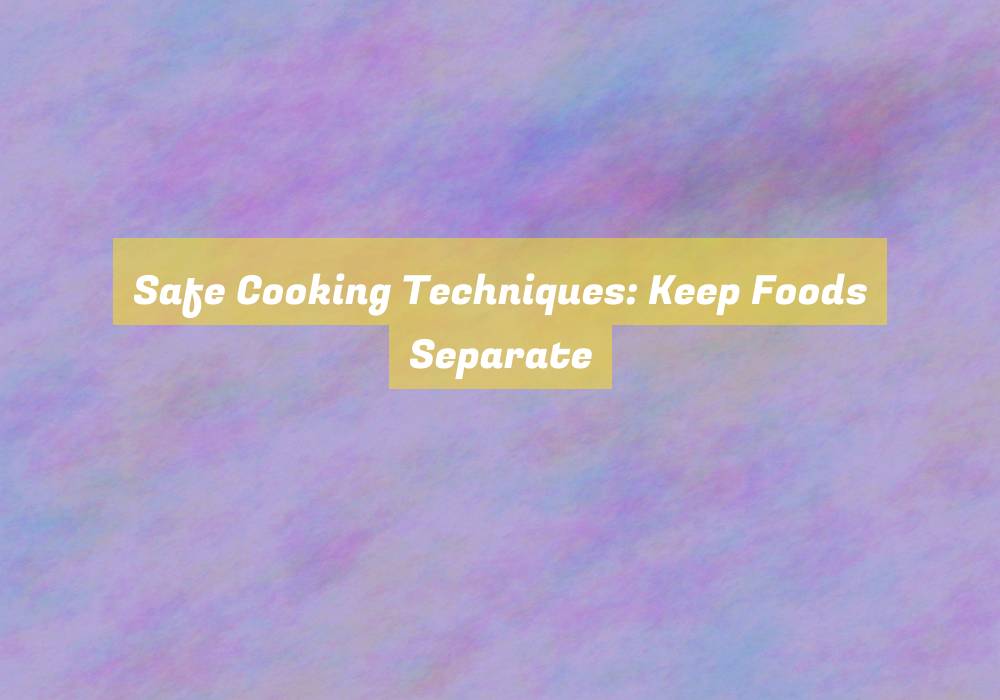Safe Cooking Techniques: Keep Foods Separate
When it comes to safe cooking techniques, itG??s essential to be mindful of keeping foods separate to ensure the well-being of those youG??re cooking for. You might not realize the potential dangers lurking in your kitchen, but with a few simple precautions, you can significantly reduce the risk of foodborne illnesses.
By implementing some straightforward practices, you can create a safer environment for your loved ones.
So, how can you take the necessary steps to minimize the chances of cross-contamination?
Importance of Separating Foods
To prevent cross-contamination and ensure food safety, itG??s crucial to separate different types of foods during storage and preparation. When raw meats, poultry, seafood, and eggs come into contact with ready-to-eat foods such as fruits, vegetables, and bread, thereG??s a risk of spreading harmful bacteria. By keeping these items separate, you significantly reduce the likelihood of foodborne illnesses.
ItG??s important to use different cutting boards for raw meats and produce to avoid cross-contamination. Store raw meats in containers or on trays to prevent their juices from dripping onto other foods in the refrigerator. Additionally, when preparing meals, use separate utensils and equipment for raw and cooked foods. This simple practice goes a long way in preventing the spread of harmful bacteria and ensuring that the meals you serve are safe to eat.
Tools for Preventing Cross-Contamination
Consider using color-coded cutting boards to designate specific boards for different food types, helping to prevent cross-contamination during food preparation. By assigning a specific color to each type of food, such as red for raw meat, green for vegetables, and blue for seafood, you can easily avoid mixing them up. This simple system can significantly reduce the risk of harmful bacteria spreading from one type of food to another.
Another effective tool for preventing cross-contamination is to have separate sets of utensils for raw and cooked foods. Using the same utensils for raw and cooked foods can lead to the transfer of harmful bacteria. Keep separate sets of knives, tongs, and other utensils to ensure that bacteria from raw foods donG??t come into contact with cooked or ready-to-eat foods.
Additionally, investing in a good quality food thermometer can help you ensure that your food is cooked to the proper temperature, killing any harmful bacteria. Using these tools in your kitchen can greatly reduce the risk of cross-contamination and help you and your family stay safe and healthy.
Best Practices for Food Preparation
To ensure safe food preparation in your kitchen, itG??s important to follow best practices that complement the tools used to prevent cross-contamination, such as color-coded cutting boards and separate sets of utensils for raw and cooked foods.
When preparing food, start by washing your hands thoroughly with soap and water before and after handling any raw ingredients. Additionally, use separate cutting boards for raw meat, poultry, seafood, and vegetables to avoid cross-contamination.
ItG??s also crucial to clean and sanitize all surfaces, utensils, and equipment that come into contact with raw foods. Be mindful of the order of food preparation – always prepare raw meat, poultry, or seafood separately from other foods to prevent the spread of harmful bacteria.
Another best practice is to use a food thermometer to ensure that meats and other potentially hazardous foods are cooked to the proper internal temperature.
Safe Storage and Refrigeration Techniques
When storing food in the refrigerator, remember to keep raw meat, poultry, and seafood separate from other ready-to-eat foods to prevent cross-contamination. Store raw meats in sealed containers or plastic bags on the bottom shelf to ensure that any juices that may leak out donG??t come into contact with other foods.
ItG??s also important to keep eggs in their original carton and not on the door, as the temperature on the door fluctuates more than the rest of the refrigerator. Leftovers should be stored in shallow, airtight containers to allow for quick cooling and to prevent the growth of bacteria. Be sure to label containers with the date the food was prepared to help track how long it has been in the refrigerator.
Additionally, regularly clean your refrigerator to prevent the buildup of bacteria and mold. Following these simple storage and refrigeration techniques will help keep your food safe and prevent foodborne illnesses.
Conclusion
So remember, keeping foods separate is crucial for preventing cross-contamination and ensuring safe cooking. Use separate cutting boards and utensils for raw meats and produce, and always wash your hands and surfaces after handling raw meat.
Store cooked and raw foods in separate containers in the refrigerator, and make sure to follow safe storage and refrigeration techniques.
By practicing these simple steps, you can help keep yourself and your loved ones safe from foodborne illnesses.






